Cloud Painters, Alien Blobs, and War in the Asteroids: March-April 2024 Print SF Magazines
 |
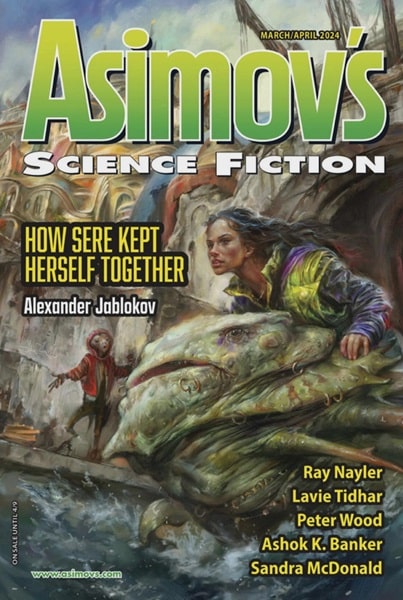 |
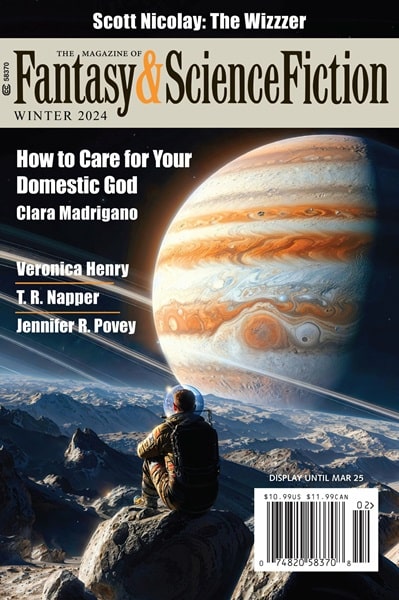 |
March-April 2024 issues of Analog Science Fiction & Fact, Asimov’s Science Fiction, and the
Winter 2024 Magazine of Fantasy & Science Fiction. Covers by Eli Bischof (for “Ganny Goes
to War”), Eldar Zakirov (for “How Sere Kept Herself Together”) and Mondolithic Studios.
There’s some great old-time serial adventure in this month’s print SF magazines. In the Asimov’s SF novella “How Sere Kept Herself Together,” Alexander Jablokov brings back his cynical detective Sere Glagolit (introduced in “How Sere Picked Up Her Laundry,” in July/August 2017, and “How Sere Looked for a Pair of Boots,” January/February 2019) to discover why her client is being aggressively stalked by an enigmatic alien Cryptor.
And in “Brood Parasitism” Auston Habershaw gives us another exciting tale of the shape-shifting alien Tohrroid (first seen in Analog in Jan/Feb 2019, and most recently in the Nov/Dec 2023 issue), this time on a mission to assassinate the leader of an invading alien army. And in “Charon’s Final Passenger” in Asimov’s, Ray Nayler returns to the setting of his popular story “Berb by Berb” in the November/December 2023 issue.
We covered the contents of the Winter 2024 F&SF (delayed by printer problems) last month, but don’t despair! The new issues of Analog and Asimov’s Science Fiction are packed with intriguing new fiction by David Gerrold, Sandra McDonald, Ashok K. Banker, Lavie Tidhar, Faith Merino, William Ledbetter, Sean Monaghan, Matt McHugh, Adam-Troy Castro, Don D’Ammassa, Karen Heuler, and lots more. The enticing details await below.
Sam Tomaino enjoyed the latest Asimov’s, and discusses it in detail at SFRevu.
“Turtles to the Sea” by Sandra McDonald
A time traveler is stranded in 1958 on a barrier island off the coast of Georgia but manages to make a life for himself, always waiting rescue. But odd things are happening in the time stream…
“The Last Cloud Painter” by Rajan Knanna
Oliver is a Black man in 1908 who travels around the Midwest in his balloon, painting clouds. He could settle down to a regular job, marry, and have a mundane life but he cannot do that. His travels take him far away, even over the Atlantic Ocean, in a boat. And he paints. Beautifully written.
“Charon’s Final Passenger” by Ray Nayler
A flying saucer crashed in New Mexico in 1938 and the United States had got much technology from it. Stalin had been purged by his generals and the Soviet Union was short-lived. The Americans had defeated Hitler and turned Berlin into ashes… There has been continuous war in Europe and Asia with the U.S. and its allies having extended World War II to drive Stalin out of Eastern Europe. Chiang Kai-shek butchered the Chinese Communists. The story is set in war-torn Georgia.
One of the technologies allows someone to assess the memories of a dead man and that is what is happening in this story, a man named Sorok… His memories are being carried by an American woman named Sylvia, our narrator. Our protagonists have encountered a man named Koba, which was Stalin’s nickname. What mark will Sorok’s memories leave on Sylvia when she leaves?
Good story!The issue concludes with the novella, “Une Time Machine, S’Il Vous Plait” by Peter Wood.
In 2023, the successful CEO of a Canadian coffee shop franchise built a spaceship to travel to the Moon. It uses a tachyon drive that had been proposed years ago by someone who had since died. On board beside herself is her no-account brother, and two aging stars of a Canadian Star Trek-like television series that had run in the 1970s. Something goes wrong and two of the passengers find themselves transported back in time… Great story!
Read Sam’s complete review here.
I frequently find myself quoting heavily from Victoria Silverwolf’s excellent reviews at Tangent, and this month is no exception. Here’s a short snippet from her lengthy review of the new Analog.
Anchored by a new novella from a veteran, award-winning author, this issue offers settings ranging from Earth in the near future to the far reaches of the galaxy.
“Brood Parasitism” by Auston Habershaw is one of a series of stories narrated by a shapeshifting alien blob. In this tale, it acts as an assassin, intent on killing the leader of another species of alien who annihilated the innocent inhabitants of a third alien planet… This story is darker than others in the series, dealing as it does with genocide and vengeance… Previous works had a touch of sardonic wit, but this one is unrelievedly grim.
The protagonist of “A Reclamation of Beavers” by Romie Stott communicates with an artificial intelligence to monitor a colony of beavers in an environmentally protected area. During a severe forest fire, the AI interprets arriving firefighters as intruders. The main character has to figure out a way to allow the AI to perceive them differently. The plot is clever, if simple, and makes the point that AIs (at least as they currently exist) have serious limitations. The most appealing aspect of this story may be the author’s obvious respect for the benefits that beavers offer the environment.
The title characters of “Daisy and Maisie, External Hull Maintenance Experts” by Sean Monaghan are robots working on the exterior of a spaceship in orbit around Phobos. A man is also outside the vessel, doing repair work… Multiple things go wrong with his spacesuit and the ship itself, threatening to kill the man. The two robots do what they can to help… The robots are appealing characters, playful and eccentric, but also loyal and self-sacrificing.
“Undertow” by Gregor Hartmann takes place in a near future United States of climate change and an increasingly oppressive government. A young man agrees to take part in a scientific experiment rather than face the possibility of being drafted to fight dangerous fires…. Very well written, with three-dimensional characters and plausible speculation, this story offers a thoughtful look at issues that are likely to be of great importance to the United States in days to come… One interesting aspect of the plot is an imaginary video game played by the Mexicans, set in a steampunk version of the 19th century, in which a surviving Aztec Empire sets out to conquer its northern neighbor. The analogy with the protagonist’s vision of his future is clear.
“Ganny Goes to War” by David Gerrold takes place at a time in the future when much of the solar system is settled. The main characters live and work on a spinning space station in the asteroid belt… A greedy corporation based on Mars takes control of the station. However, the matriarch of the family is prepared… With other inhabitants of the asteroid belt, they set up a new independent nation, fighting the corporation with diplomacy and, when necessary, war. The highest praise I can offer for this engaging tale is that it reminds me of classic Heinlein. It has the same clear, informal, very readable narrative style… the story also contains great depth of character.
Read Victoria’s complete review here.
Here’s all the details on the latest SF print mags.
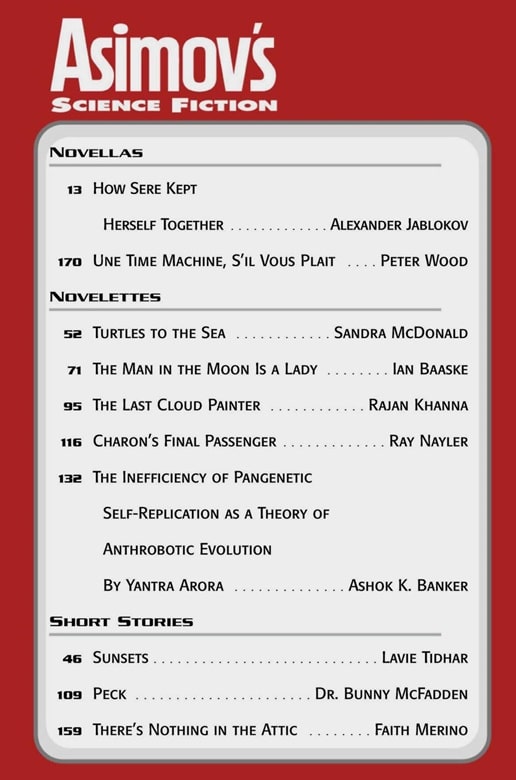 |
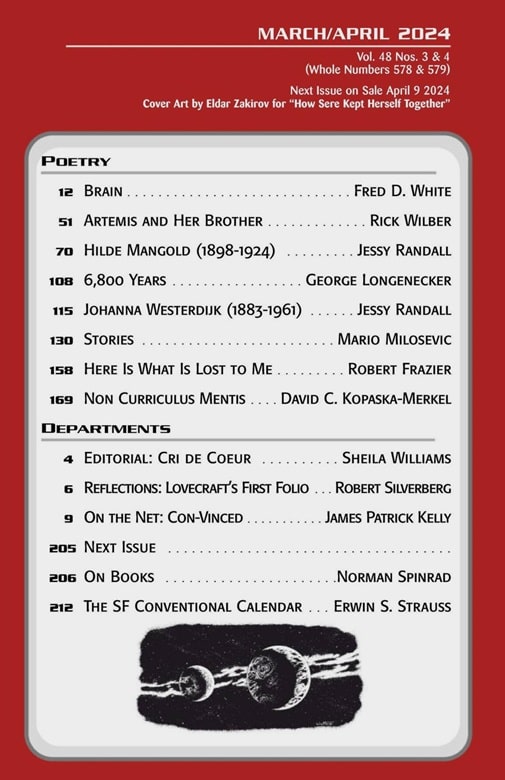 |
Contents of the March-April 2024 issue of Asimov’s Science Fiction
Asimov’s Science Fiction
Sheila Williams provides a handy summary of the latest issue of Asimov’s at the website.
Our March/April 2024 issue is filled with fun! Alex Jablokov returns with a novella about his fashion-conscious, somewhat hapless detective living amid a multitude of aliens. This time we discover “How Sere Kept Herself Together.” We’re also featuring Peter Wood’s delightful novella about time travel, sibling rivalry, alternate sixties television shows, restaurant chains, and much more. Don’t hesitate to request “Une Time Machine S’il Vous Plait”!
Rajan Khanna creates a whimsical and bittersweet portrait of “The Last Cloud Painter”; Ray Nayler sears us with a tale about “Charon’s Final Passenger.” We have a quartet of authors whose fiction is new to Asimov’s: Faith Merino reveals that “There’s Nothing in the Attic” (probably); Ashok K. Banker relays “The Inefficiency of Pangenetic Self-Replication as a Theory at Anthrobotic Evolution by Yantra Arora”; Dr. Bunny McFadden flies in “Peck”; and Ian Baaske inventively shows that “The Man in the Moon Is a Lady.” In addition, Sandra McDonald brings us a thoughtful story about families, history, and “Turtles to the Sea”; and Lavie Tidhar awes us with a tale about love and loss and “Sunsets.”
Robert Silverberg’s Reflections discusses “Lovecraft’s First Folio”; James Patrick Kelly’s On the Net will have you “Con-vinced”; Norman Spinrad’s On Books considers works by C.T. Rwizi, Brandon Q. Morris, and Lavanya Lakshminarayan. Plus we’ll have an array of poetry you’re sure to enjoy.
Get your copy now!
Here’s the complete Table of Contents.
Novellas
“How Sere Kept Herself Together” by Alexander Jablokov
“Une Time Machine, S’Il Vous Plait” by Peter Wood
Novelette
“Turtles to the Sea” by Sandra McDonald
“The Man in the Moon is a Lady” by Ian Baaske
“The Last Cloud Painter” by Rajan Knanna
“Charon’s Final Passenger” by Ray Nayler
“The Inefficiency of Pan Genetic Self-Replication as a Theory of Anthrobotic Evolution by Yantar Arora” by Ashok K. Banker
Short Stories
“Sunsets” by Lavie Tidhar
“Peck” by Dr. Bunny McFadden
“There’s Nothing in the Attic” by Faith Merino
Poetry
Brain by Fred D. White
Artemis and Her Brother by Rick Wilber
Hilde Mangold (1898-1924) by Jessy Randall
6,800 Years by George Longenecker
Johanna Westerdijk (1883-1961) by Jessy Randall
Stories by Mario Milosevic
Here is What is Lost to Me by Robert Frazier
Non Curriculus Mentus by David C. Kopaska-Merkel
Departments
Editorial: Cri de Coeur by Sheila Williams
Reflections: Lovecraft’s First Folio by Robert Silverberg
On the Net: Con-Vinced by James Patrick Kelly
Next Issue
On Books by Norman Spinrad
The SF Conventional Calendar by Erwin S. Strauss
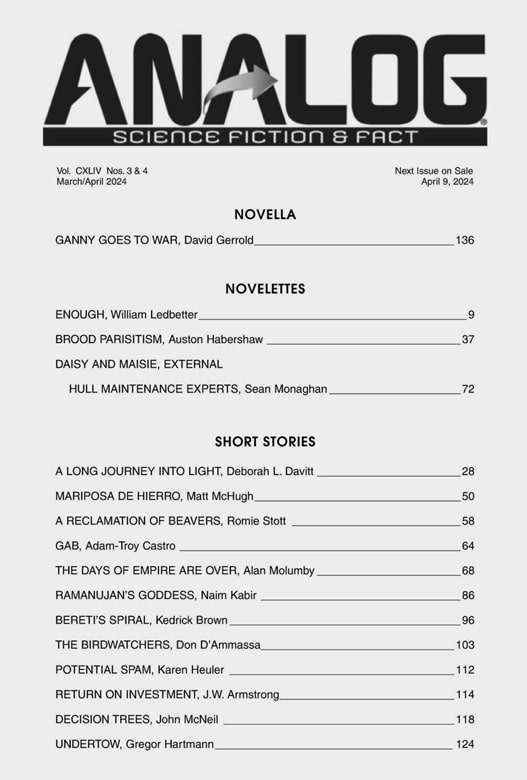 |
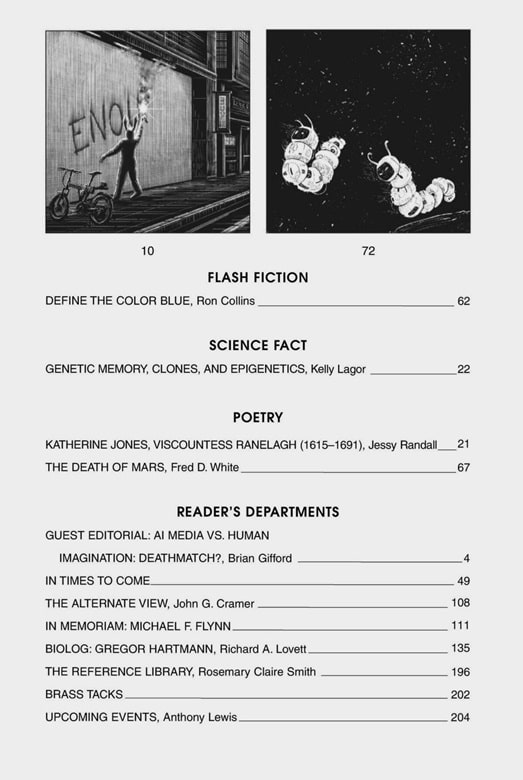 |
Contents of the March-April 2024 issue of Analog Science Fiction
Analog Science Fiction & Science Fact
Editor Trevor Quachri gives us a tantalizing summary of the current issue online, as usual.
In our March/April issue, we have some real bangers, including a long novella from David Gerrold that shows just what one small but highly motivated group can do when left with no alternative, in “Ganny Goes to War”; a look at a future in which consumers have finally had “Enough,” from William Ledbetter; the next chapter in the (mis)adventures of a certain amorphous shape-shifter, in Auston Habershaw’s “Brood Parasitism”; a survey of the current state of epigenetics, both in real life and SF, by Kelly Lagor; a couple of tax/prank season-appropriate stories from Don D’Ammassa and John W. Armstrong; and much, much more, from Gregor Hartmann, Romi Stott, Adam-Troy Castro, Deborah L. Davitt, and others.
Here’s the full TOC.
Novella
“Ganny Goes to War,” David Gerrold
Novelettes
“Enough,” William Ledbetter
“Brood Parisitism,” Auston Habershaw
“Daisy and Maisie, External Hull Maintenance Experts,” Sean Monaghan
Short Stories
“A Long Journey Into Light,” Deborah L. Davitt
“Mariposa De Hierro,” Matt Mchugh
“A Reclamation of Beavers,” Romie Stott
“Gab,” Adam-troy Castro
“The Days Of Empire Are Over,” Alan Molumby
“Ramanujan’s Goddess,” Naim Kabir
“Bereti’s Spiral,” Kedrick Brown
“The Birdwatchers,” Don D’ammassa
“Potential Spam,” Karen Heuler
“Return On Investment,” J.w. Armstrong
“Decision Trees,” John Mcneil
“Undertow,” Gregor Hartmann
Flash Fiction
“Define the Color Blue,” Ron Collins
Science Fact
Genetic Memory, Clones, and Epigenetics, Kelly Lagor
Poetry
Katherine Jones, Viscountess Ranelagh (1615–1691), Jessy Randall
The Death of Mars, Fred D. White
Reader’s Departments
Guest Editorial: AI Media vs. Human Imagination: Deathmatch?, Brian Gifford
In Times to Come
The Alternate View, John G. Cramer
In Memoriam: Michael F. Flynn
Biolog: Gregor Hartmann, Richard A. Lovett
The Reference Library, Rosemary Claire Smith
Brass Tacks
Upcoming Events, Anthony Lewis
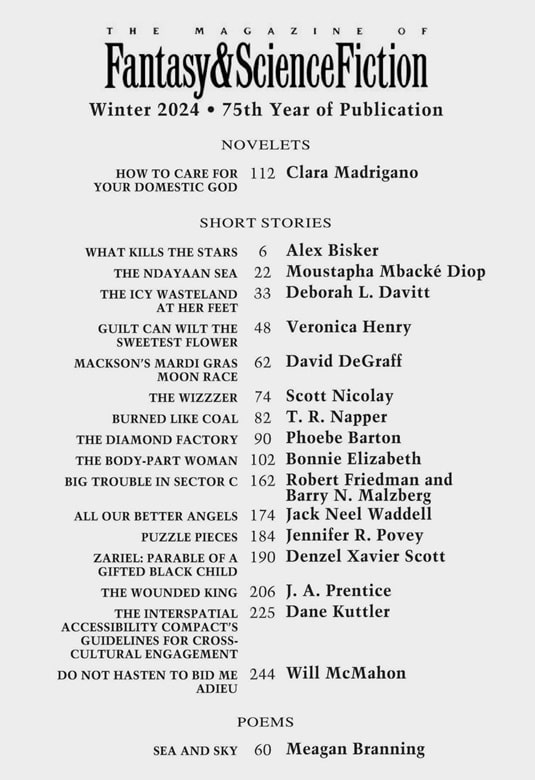 |
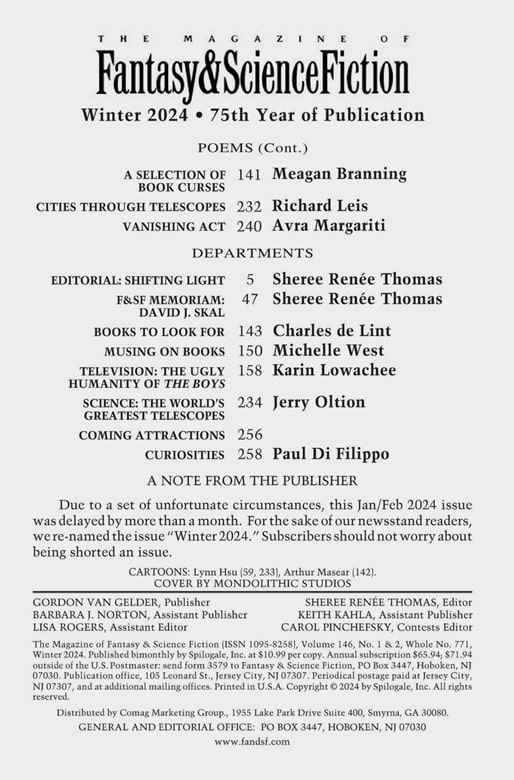 |
Contents of the Winter 2024 issue of The Magazine of Fantasy & Science Fiction
The Magazine of Fantasy & Science Fiction
See our compete coverage of the Winter 2024 issues of F&SF last month.
Analog, Asimov’s Science Fiction and The Magazine of Fantasy & Science Fiction are available wherever magazines are sold, and at various online outlets. Buy single issues and subscriptions at the links below.
Asimov’s Science Fiction (208 pages, $8.99 per issue, one year sub $47.97 in the US) — edited by Sheila Williams
Analog Science Fiction and Fact (208 pages, $8.99 per issue, one year sub $47.97 in the US) — edited by Trevor Quachri
The Magazine of Fantasy & Science Fiction (256 pages, $10.99 per issue, one year sub $65.94 in the US) — edited by Sheree Renée Thomas
The March-April issues of Asimov’s and Analog are on sale until April 9. See our coverage of the January-February issues here, and all our recent magazine coverage here.